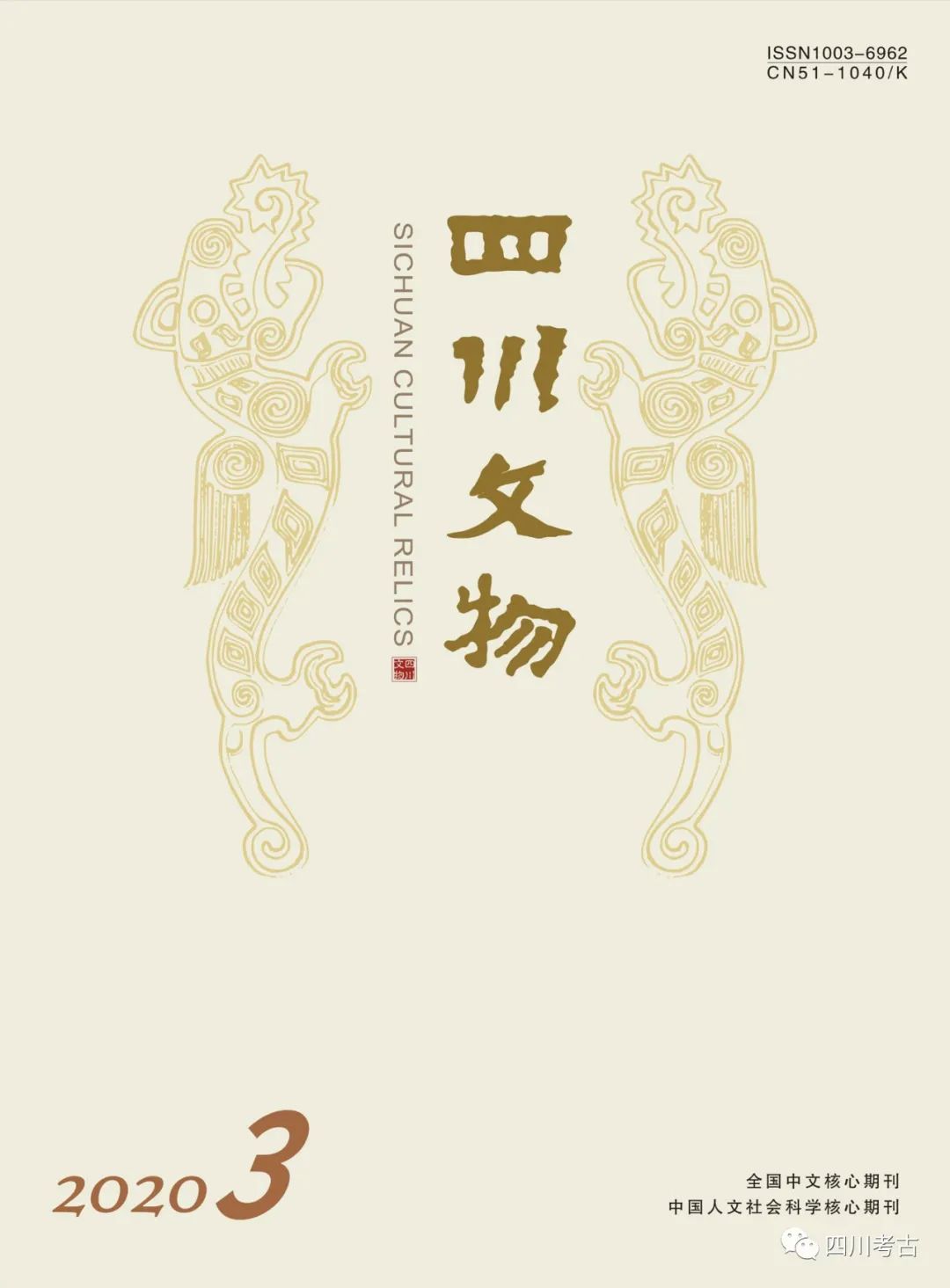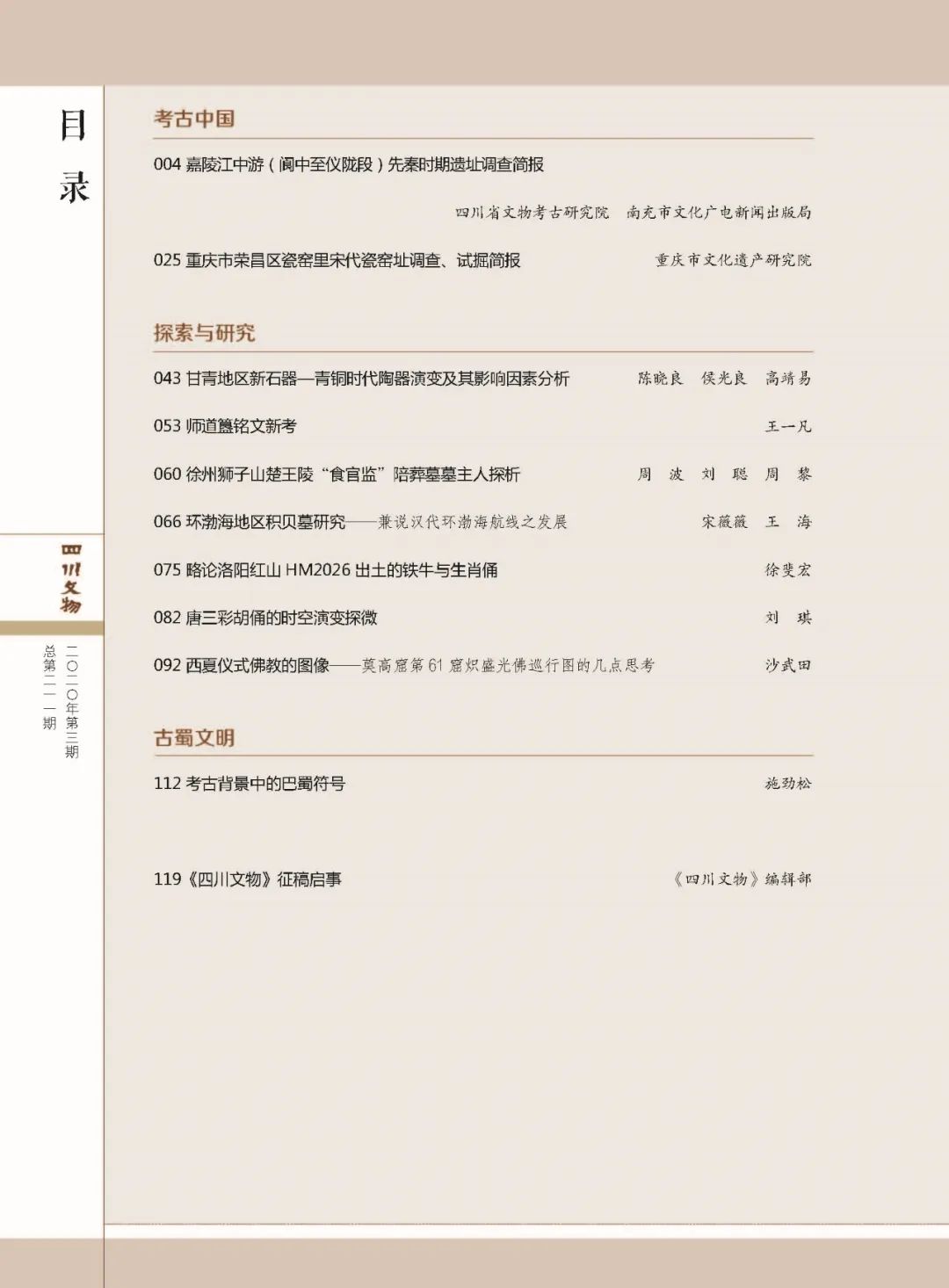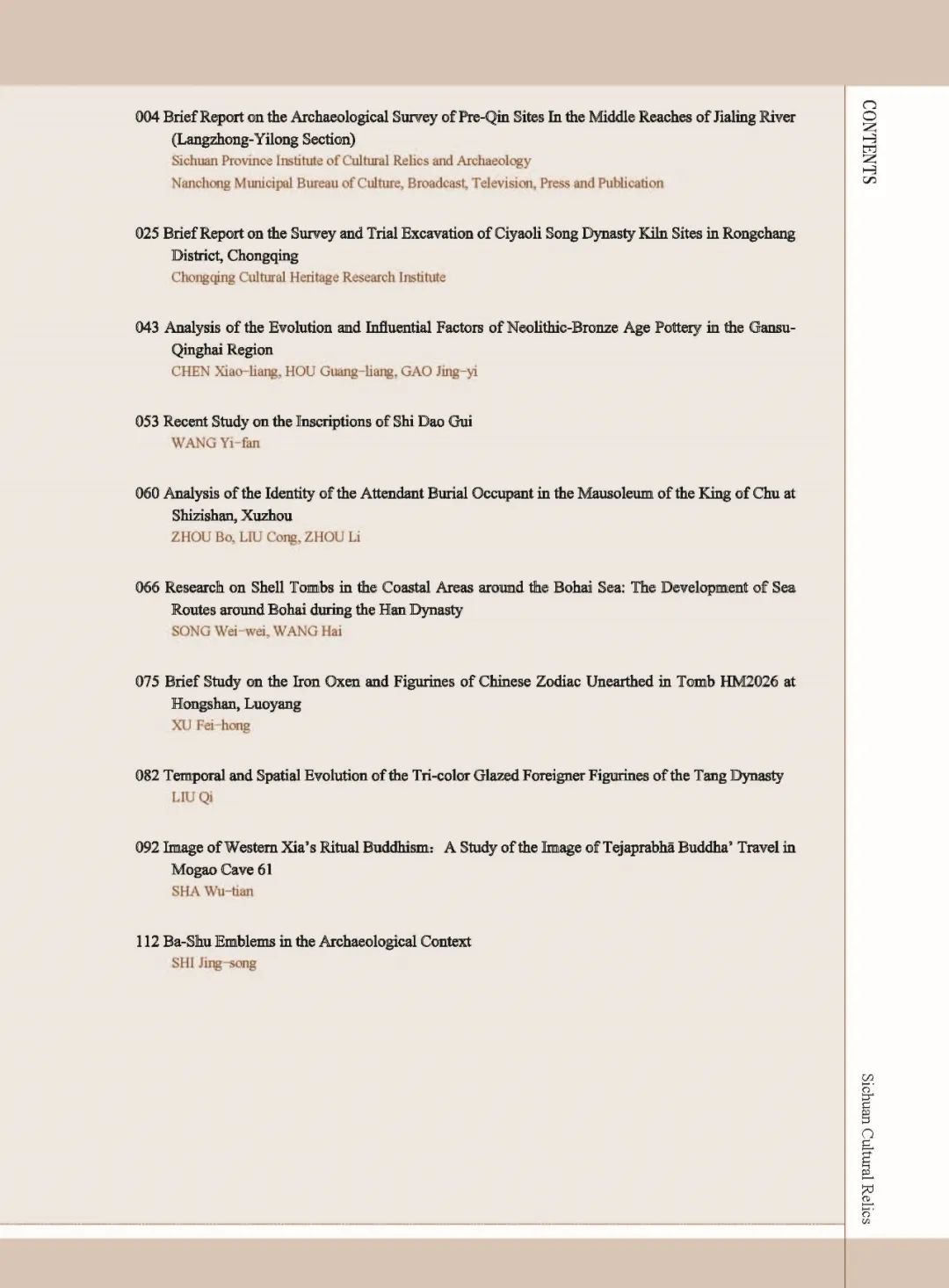书籍资料库
《四川文物》2020年第3期目录及摘要




中文摘要
考古中国
嘉陵江中游(阆中至仪陇段)先秦时期遗址调查简报
四川省文物考古研究院
南充市文化广电新闻出版局
摘要:2018年1月至2018年4月,四川省文物考古研究院等单位对嘉陵江中游(阆中至仪陇段)进行了考古调查,调查共发现先秦遗址12处,扩充了嘉陵江流域先秦遗址的内涵,为进一步探讨该区域先秦遗存的分布状况、考古学文化面貌及聚落形态等提供了新的线索。
关键词:阆中市;南部县;仪陇县;先秦;聚落
重庆市荣昌区瓷窑里宋代瓷窑址调查、试掘简报
重庆市文化遗产研究院
摘要:2005年11月至12月,重庆市文物考古所(今重庆市文化遗产研究院)对位于重庆市荣昌县安富镇大院村6组(今荣昌区安富街道通安村14组)的瓷窑里窑址进行了调查,发现宋代窑址4处,分别为罗汉坟窑址、堰口屋基窑址、桂花屋基窑址和松树林窑址,并对松树林窑址进行了试掘。采集和出土了大量瓷器、窑具等。确认瓷窑里为以烧造黑釉瓷为核心的瓷窑遗存。基本厘清了窑址分布情况、生产规模及其产品特征。此次调查、试掘为宋代民间制瓷手工业研究提供了较为丰富的实物资料。
关键词:瓷窑里;宋代瓷窑址;黑釉瓷;白釉瓷
探索与研究
甘青地区新石器
——青铜时代陶器演变及其影响因素分析
陈晓良(青海师范大学地理科学学院)
侯光良(青海师范大学高原科学与可持续发展研究院)
高靖易(青海师范大学地理科学学院)
摘要:甘青地区新石器时代——青铜时代陶器演变规律及其影响因素的研究相对薄弱,陶器演变的过程与机制尚不清晰。根据甘青地区新石器——青铜时代7个文化序列的21处遗址点出土陶器数量、高度及组合(种类)可知在新石器—铜石并用时期,罐类数量比例上升,盆、壶、瓮类数量比例和高度(罐除外)下降,组合由复杂演变为简单;青铜时代中晚期的卡约文化时期,罐类数量比例达到最高,盆、壶、瓮类器皿数量比例衰落发展;辛店文化至寺洼文化时期,罐类比例和高度较卡约文化时期下降,盆、壶类数量比例和高度上升,组合由简单演变为复杂。结合研究区周边的气候记录及考古材料,发现气候变化、生产水平、生计方式、社会组织、财富观念及技术革新等是导致甘青地区陶器演变的影响因素。
关键词:甘青地区;新石器—青铜时代;陶器;演变
师道簋铭文新考
王一凡(中国社会科学院大学研究生院)
摘要:师道簋是内蒙古宁城县出土的一件西周时期重要青铜器,簋铭94字,反映了益公、师道与辛公的相关史事。通过金文历谱的计算,可以求得师道簋铭具体年代为“周夷王三年(前883年)二月初吉丁亥”。通过与“吴虎鼎”“师晨鼎”“繁卣”等器铭的对读,“道”与“辛公”等人的关系也得以体现。
关键词:师道簋;小黑石沟;金文;西周历法
徐州狮子山楚王陵“食官监”陪葬墓墓主人探析
周波(徐州狮子山楚王陵管理处)
刘聪(徐州汉兵马俑博物馆)
周黎(徐州狮子山楚王陵管理处)
摘要:殉人现象在西汉诸侯王墓葬中时有发现,如徐州的狮子山楚王陵墓、广州的南越王墓等。狮子山楚王陵墓墓道内发现陪葬墓1座,墓室内2座。其中位于墓道内陪葬墓未被盗扰,出土印文为“食官监印”的铜印一方。据此,发掘者及相关研究学者多将其称为“食官监”陪葬墓,认为墓主为负责楚王饮食的食官监。该陪葬墓出土铜鼎、铜印、玉枕、玉璧、玉璜、铁剑、无字玉印等随葬品,出土器物数量及组合说明墓主生前具有较高的等级地位,与“食官监”一职不甚相符。因此,墓主生前当有更高的职位。墓葬内出土一方无字玉印,玉印原应朱书或墨书官职名称,此印或能 代表墓主生前最高身份。
关键词:狮子山楚王陵;食官监;陪葬墓;玉枕;无字玉印
环渤海地区积贝墓研究
——兼论汉代环渤海航线之发展
宋薇薇(中原工学院信息商务学院)
王海(渤海大学历史文化学院)
摘要:积贝墓是环渤海地区战国秦汉时期具有地域特色的墓葬形式,以往研究多着力于考古发现,对其蕴含的历史文化的关注有待加强。通过对辽南、辽西、山东北部沿海地区积贝墓的统计与对比分析,其在墓室结构、出土器物等方面的一致性更为彰显,夯实了学界已有的相关观点,表明墓主人应属于当时环渤海地区具有相近社会文化面貌的人群。战国秦汉时期,燕、齐之地海上交通发展显著,环渤海地区以徐乡、之罘、庙岛群岛、沓津等为代表的港口,或日臻完善、或初见雏形,环渤海航线得以发展并渐趋成熟。积贝墓集中发现之处,恰与上述古代港口分布有空间重合,应可视为上古时代环渤海海上交通发展的考古学印证。不过,中原文化亦借此在环渤海地区传播、植根,积贝墓的演进与消失或是当地海洋文明吞没于华夏农耕文明历史浪潮中 的一个反映。
关键词:积贝墓;考古发现;区域文化;港口;环渤海航线
略论洛阳红山HM2026出土的铁牛与生肖俑
徐斐宏(北京大学考古文博学院)
摘要:洛阳红山HM2026是一座未出土纪年材料的唐代墓葬。此墓年代应在710年左右,而非发掘者认为的玄宗至代宗时期。红山HM2026出土了铁牛与生肖俑,使这两类盟器神煞在唐两京地区出现的时间有了不同幅度的提前,且其中铁牛的发现,还印证了《大唐新语》中的相关记载。透过HM2026的铁牛与生肖俑,可见“四神”之外的盟器神煞在唐代东、西两京的出现时间与流行程度存在一定区别,相对洛阳而言,长安处于更为保守的位置。
关键词:铁牛;生肖俑;盟器神煞;两京唐墓
唐三彩胡俑的时空演变探微
刘琪(陕西师范大学历史文化学院)
摘要:唐三彩是唐代重要的陶瓷手工艺品,作为陪葬品在唐墓中被大量发现。其中,很多三彩人俑都以胡人为形象。从时间上看,这些三彩胡俑最早出现于武周时期,中宗时数量剧增,玄宗时期制作工艺渐臻成熟,安史之乱以后则逐渐减少直至消失;从空间上看,三彩胡俑在以长安、洛阳为中心的两京地区发现最多,其他北方地区也有少量分布。南方地区发现的主要是中晚唐时期的三彩胡俑。三彩胡俑时空分布的演变,为认识唐代区域经济文化变迁及域外文化传播提供了生动的历史见证与线索。
关键词:唐代;三彩胡俑;时空分布;南北变迁;文化交流
西夏仪式佛教的图像
——莫高窟第 61 窟炽盛光佛巡行图的几点思考
沙武田(陕西师范大学人文社会科学高等研究院)
摘要:敦煌莫高窟第61窟甬道南北壁两铺大型炽盛光佛巡行图壁画,作为后期重绘的壁画,对其时代的判定有元、西夏两种观点,其中持元代说者以“元代西夏遗民营建”说为代表,但经仔细观察画面细节,作些辨析,持主流意见的西夏说更能成立,而由西宁王速来蛮主导营建的说法,完全不能成立。作为炽盛光佛变相的特例,画面反映出来的炽盛光佛巡行和本地僧团送、迎的场面,是重绘壁画时受西夏仪式佛教影响的结果,是西夏佛教重实践、重仪轨的图像记忆。而炽盛光佛星曜信仰浓厚的国家倾向,结合西夏佛教的官方特色,以及西夏时期沙州所处的社会背景,可以看到西夏人在第61窟的重绘活动,实际有地方官府和佛教界对国家和地方消灾祈福的强烈表达。
关键词:炽盛光佛巡行图;西夏佛教;炽盛光佛星曜信仰;仪式佛教;官方佛教
古蜀文明
考古背景中的巴蜀符号
施劲松(中国社会科学院考古研究所)
摘要:对于东周秦汉时期流行于四川盆地的巴蜀符号,除了研究其自身的形态、种类、组合外,考察它们产生、流行的时代背景和具体的出土背景应有助于认识符号的性质以及使用者之间的关系。巴蜀符号可能是族徽,四川盆地内重要墓葬出土的符号显示出它们产生和分布的特点,以及各区域之间的关联。由巴蜀符号我们可以从另一角度构建四川盆地战国秦汉时期的文化与社会图景。
关键词:巴蜀符号;考古背景;墓葬;区域关系;文化因素
英文摘要
Brief Report on the Archaeological Survey of Pre-Qin Sites
In the Middle Reaches of the Jialing River (Langzhong-Yilong Section)
ABSTRACT:The Jialing River originates from the Dai Wang Mountain at the northern slope of the Qinling Mountains in Fengxian County, Shaanxi Province. With a total length of 1,345 km, it is a level 1 tributary of the Yangtze River and a channel connecting the Chengdu Plain and the upper reaches of the Yangtze River west of the Three Gorges, as well as connecting Hubei and Shaanxi through the upper reaches of the Han River (Hanshui). The connections suggest the extreme importance of the Jialing River valley for us to understand the interactions of Pre-Qin cultures throughout the Sichuan region. However, the lack of archaeological workgoes against in-depth studies in this region.From January to April 2018, Sichuan Province Institute of Cultural Relics and Archaeology and other institutions jointly conducted archaeological surveys in the middle reaches of the Jialing River (Langzhong-Yilong section), finding 12 Pre-Qin sites in total.
Key words:Langzhong,Nanbu County,Yilong County, Pre-Qin,settlement
Brief Report on the Survey and Trial Excavation of Ciyaoli Song Dynasty Kiln Sites in Rongchang District, Chongqing
Abstract:From November to December 2005, Chongqing Institute of Cultural Relics and Archaeology (present Chongqing Cultural Heritage Research Institute) investigated the Ciyaoli kiln site cluster located in Group 6 of Dayuan Village, Anfu Town, Rongchang County, Chongqing (present Group 14 of Tongan Village, Anfu sub-district, Rongchang District). During the investigation, four kiln sites of the Song Dynasty were found, including the Luohanfen kiln site, Yankouwuji kiln site, Guihuawuji kiln site, and songshulin kiln site. Furthermore, trial excavation was conducted at the Songshulin kiln site. A large number of porcelain and kiln furnitures were collected and unearthed. The four kiln sites were all civilian kilns mainly producing black glazed porcelain of daily use, including wan (bowls), zhan (small cups used for drinking), pan (plates), bei (cups), guan (jars), pen (basins), ping (vases), and dengzhan (lamps). The biscuits were very regular in shape as they were mainly fabricated by hand through wheel building. The small cups were often made with flat bottoms, while few of them had “yubi” foot-rims (broad ring foot resembling a jade ring). The vessels were fired at relatively high temperature, yielding greyish-white, reddish-brown, greyish-brown and greyish-black coarse bodies, as most of them were greyish-white. Underfired and overfired samples were also observed. The majority of cups, bowls and plates were made with ring foot; flat-bottom vessels were extremely rare. Pitch-black and blackish-brown glazes were dominant, yet there were also rare samples of dark reddish-brown glaze. Due to the nonuniform thickness of glaze, thick accumulations of glaze were often noticed at the bottom of the interior of the vessels, while the bottom of the exterior was ususlly exposed. Sagging glaze was noticed on a few samples. There were biscuit decorations, underglaze decorations and decorations inside the glaze. As for black glazed porcelain in Chongqing, the vessles with blue hare’s-fur streaks were particularly rare works of art. The firing process was conducted with or without saggers. The distributions, production scales and product features of the kilns were generally figured out through the survey and trial excavation. Rich materials were acquired for the study of civilian porcelain productions during the Song Dynasty.
Key Words:Ciyaoli kiln site cluster, Song dynasty kiln sites, black glazed porcelain, white glazed porcelain
Analysis of the Evolution and Influential Factors of Neolithic-Bronze Age Pottery in the Gansu-Qinghai Region
Abstract:The Gansu-Qinghai region possesses a pottery art comparable to that of any other area in China. In this paper, weexplore the evolutionary law of pottery in Neolithic and BronzeAges, on the basis of the quantity, heightand combination of pottery unearthed from 21 sites of 7 cultures in chronological sequence. Our analysis on the possible influences shows that from the Neolithic Age to theChalcolithic Age,the proportion of pots increased,while the proportion andheight of tubs, kettles and urns decreased,and their combinations changedfromcomplexity to simplicity. The primary causes were probably related to the change of subsistencestrategy under the influence of climate change and the introduction of external goods from the west, while the secondary causes might have something to dowith the transformation of social organization and the ancestor’s change of view about wealth.During the Kayue culture period in the mid-late Bronze Age, the proportionof pots reached its peak, and the proportion of tubs, kettles and urns declined, probably because thesubsistence strategy of Kayue culture adapted to the climate change. During the period of Xindianculture and Siwa culture, comparing with Kayue culture, the proportion andheight of pots decreased, while the proportion and height of tubs and kettles increased, and theircombinationschanged from simplicity to complexity, which probably had close correlationsto the development of productivity and stable agricultural settlement life. In conclusion, we believethat the quantity, height and combination of pottery during the Neolithic and Bronze Ages inGansu-Qinghai region were closely related to the climate change, productivity, subsistence strategy,social organization, view about wealth and technical innovation in this area.
Key Words:Gansu-Qinghai region, Neolithic-Bronze Age, Pottery, evolution
New Study on the Inscription of Shi Dao Gui
Abstract:Shi Dao Gui 师道簋 (Gui of Shi Dao) is an important bronze artifact from the Western Zhou Dynasty unearthed in Ningcheng County, Chifeng City. Inscription on it contains 94 characters, which records the related historical events of Yi Gong 益公, Shi Dao 师道 and Xin Gong 辛公. Calculation based on the Bronze Inscription Calendar indicates the specific age of Shi Dao Gui as“chuji ding hai of February (二月初吉丁亥) in the third year of King Yi’s reign in the Zhou Dynasty (周夷王三年) (883 BC)”. Cross-reference interpretation of bronzes including Wu Hu Ding 吴虎鼎 (Ding of Wu Hu), Shi Chen Ding 师晨鼎 (Ding of Shi Chen) and Fan You 繁卣 (You of Fan) also provides us with an understanding of the relationship between Dao 道 and Xin Gong 辛公.
Key Words:Shi Dao Gui, Xiaoheishigou cemetery, Bronze Inscriptions, Western Zhou calendar
Analysis of the Identity of the Attendant Burial Occupant in the Mausoleum of the King of Chu at Shizishan, Xuzhou
Abstract:The phenomena of human sacrifices are often observed in the tombs of vassal kings of the Western Han Dynasty, such as the mausoleum of the king of Chu at Shizishan ("Lion Hill") in Xuzhou, and the mausoleum of the king of Nanyue in Guangzhou. In the mausoleum of the king of Chu, three "attendant burials" were discovered, including one in the tunnel and two in the tomb chamber. From the one in the tunnel which stayed intact, a bronze seal was unearthed bearing the inscription of "shi guan jian yin" ("seal of the official for delicacies"). Based on it, the burial was referred to as "burial of the official for delicacies" by the excavators and a number of scholars, arguing that the occupant of the burial was the official for diet in the court of the king of Chu. Besides the seal, bronze Ding (tripods), jade pillow, jade discs, jade Huang (a semi-annular jade ornament), iron swords and a plain jade seal with no inscriptions were also discovered. The quantity of funerary objects and their assemblage indicate that the tomb occupant enjoyed fairly high status in his lifetime, which does not conform to the title of "official for delicacies". Instead, he should have held a much higher position. The plain jade seal unearthed might have borne red or black ink writings of his actual title, which possibly represented his highest status before death.
Key Words:mausoleum of the king of Chu at Shizishan, official for delicacies, attendant burials, jade pillow, jade seal with no inscriptions
Research on Shell Tombsin the Coastal Areas around the Bohai Sea: The Development of Sea Routes around Bohai during the Han Dynasty
Abstract:Shell tomb was a form of burial from the Warring States Period and QinHan dynasties with regional characteristics in the coastal areas around the Bohai Sea. Previous researches mainly focused on archaeological discoveries, yet more attention is needed to revealthe historical and cultural connotations of the shell tombs. Based on statistics and comparativeanalysis of the shell tombs distributed in the coastal areas around the Bohai Sea, including southernLiaoning Province, western Liaoning Province and coastal areas in northern Shandong Province,obvious consistency on tomb structure and unearthed objects can be noticed, which reinforcesthe existing views in the academic circle that the owners of the tombs were people with similarsocial and cultural features in the coastal areas around the Bohai Sea at that time. The WarringStates period and Qin-Han dynasties witnessed remarkable development of maritime transport in the States of Yan and Qi, representative ports such as Xuxiang( 徐 乡) and Zhifu( 之 罘)became increasingly prominent, while others like Tajin(沓津) began to take shape. Besides, the sea routes around Bohai were developed and gradually matured. The loci where shell tombs werediscovered in high concentration coincide with the above-mentioned ancient ports, serving as thearcheological evidence of the development of maritime traffic around the Bohai Sea in the ancienttimes. The evolution and disappearance of shell tombs might be a reflection of local maritimecivilization being displaced by agricultural civilization from the Central Plains, whereby the latterspread and rooted in the coastal areas around the Bohai Sea.
Key Words:shell tombs, archaeological discoveries, regional culture, ports, sea routes around Bohai
Brief Study on the Iron Oxen and Figurines of Chinese Zodiac Unearthed in Tomb HM2026 at Hongshan, Luoyang
Abstract:From 2009 to 2011, the 2nd archaeological team of Luoyang City excavated five Tang tombs in Hongshan Industrial Park of Luoyang, Henan Province. HM2026, an important archaeological discovery, was one of them. Unfortunately, with its significance and value unrevealed, it has not received enough attention. According to the excavation report, HM2026 was dated to the period during Emperor Xuanzong to Emperor Daizong of the Tang Dynasty, which was not correct. Through comparison with other Tang tombs excavated in Luoyang, such as the tomb of Li Yanzhen (709 A.D.) and the tomb of Li Siben (709 A.D.), it is concluded that the date of HM2026 should be around 710 A.D. Two iron oxen and figurines of Shengxiao (Chinese Zodiac) unearthed from HM2026 were very important findings of Ming Qi ShenSha (mortuary objects and figurines of gods and spirits), which were earlier than the best evidences of these types of objects from the Tang Dynasty previously discovered in Chang'an and Luoyang. The discovery of iron oxen was particularly important as it confirmed relevant documentation in Da Tang Xin Yu (New Anecdotes of the Tang Dynasty), which proved that in the early 8th century, the custom of burying iron ox as funerary objects was at least put into practice, if not widely popular. In addition to the iron oxen and the figurines of Shengxiao, this paper also lists discoveries of other kinds of Ming Qi ShenSha in Chang'an and Luoyang of the Tang Dynasty, including futing (figurines in a prostrate position), dizhou (figurines of two-headed spirits) and door-guarding figurines. The paper points out that during the Tang Dynasty the emergence and popularity of Ming Qi ShenSha in Chang'an and Luoyang were different, except for Sishen (figurines of four deities). Compared with Luoyang, Chang'an was more conservative in terms of burial customs, perhaps because it was the real capital of the Tang Dynasty, institutional constraints on burial activities in Chang'an were more strictly conducted. The discovery of HM2026 provides valuable information for in-depth understanding on the tombs in Chang'an and Luoyang of the Tang Dynasty.
Key Words:Iron oxen, figurines of Shengxiao (Chinese Zodiac), Ming Qi ShenSha (mortuary objects and figurines of gods and spirits), Tang tombs in Chang'an and Luoyang
Temporal and Spatial Evolution of the Tri-color Glazed Foreigner Figurines of the Tang Dynasty
Abstract:Tri-color glazed pottery (sancai ceramics) of the Tang Dynasty is an important handicraft in Tang Dynasty, which was found in a large number as burial objects in tombs of TangDynasty. Among them, many Tri-color glazed figurines were made in the image of foreigners. Thecreation of the Tri-color glazed foreigner figurines can be roughly divided into four stages, andthere are different characteristics and causes with each phase of development and evolution:In the first phase, the tri-color glazed foreigner figurines first appeared in the Wu-Zhou period, which was closely related to the increase of the number of foreigners in Chang'anand Luoyang.
In the second phase, the number of the figurines increased dramatically in Zhongzong periodof Tang Dynasty. Types of the tri-color glazed foreigner figurines increased as diversification grewin the identity and occupation of foreigners in the Tang Dynasty.
In the third phase, the workmanship gradually matured in Xuanzong period of Tang Dynasty.The open social environment of the prosperous Tang Dynasty attracted a large number offoreigners, and the abundance of materials contributed to the expression of exaggeration, boldnessand integration of Chinese and foreign elements.
In the fourth phase, after the An-Shi Rebellion, tri-color glazed foreigner figurines graduallytapered off and disappeared. Due to the outbreak of An-Shi Rebellion which led to social unrest,craftsmen were unable and in no mood to create, and the hatred of foreigners aggravated thedecline of this art.
The evolution of spatial and temporal distribution of the tri-color glazed foreigner figurinesprovides a vivid historical witness and clue for the study of regional transitions economically andculturally and the spread of foreign cultures in the Tang Dynasty.
Key Words:Tang Dynasty, tri-color glazed foreigner figurines, temporal and spatial distribution, north-south changes, cultural exchanges
Image of Western Xia’s Ritual Buddhism:A Study of the Image of Tejaprabhā Buddha’ Travel in Mogao Cave 61
Abstract:The image of Tejaprabhā Buddha's travel on the north and south walls of the passageway of Mogao Cave 61 was an elaborate work of the Western Xia period. The inscriptions of the murals in Chinese and Tangut languages were the most distinguished feature of the Western Xia culture. In addition, the clothing and accessories worn by the figures in the murals were common in the works of Western Xia period. As for the identity of the figure under canopy, it is actually a popular image of the State Master in the Western Xia period. In general, it is certain that the passageway murals in Mogao Cave 61 were painted in the Western Xia period, the theory of them being painted during the Yuan dynasty is more on the basis of speculation rather than facts. The large images of Tejaprabhā Buddha's travel on the passageway walls of Cave 61 were undoubtedly a special case of the Buddhist art of Western Xia period, as well as the only case of this subject in the Western Xia murals in Dunhuang Grottoes. More importantly, the way how the cave was repainted was also an exception in Mogao, Yulin and Wugemiao Grottoes. The most outstanding characteristic of the murals is their manifestation as a queue on the move, which is highly ritualistic and embodies the ritual Buddhism of the Western Xia period. Rituality and practicalness were basic features of the Western Xia Buddhism. While emphasizing on dispelling disasters, the main purpose was the wellbeing of the State, the king and his ministers, consistent with relevant sutras of the Tejaprabhā Buddha. The reconstruction of the cave was most likely an official religious activity of the local government of Shazhou in the Western Xia period, with specific official appeals.
Key Words:Image of Tejaprabhā Buddha's travel, Buddhism of Western Xia, belief of Tejaprabhā Buddha and the Deities of stars, ritual Buddhism, official Buddhist activities
Ba-Shu Emblems in the Archaeological Context
Abstract:Existing studies on the Ba-Shu Emblems mainly focus on the emblems themselves, namely the form, direction and assemblage of them. However,the historicalbackground in which the emblems emerged and prevailed as well as their archaeological contextin burial excavations will help to understand the nature of the emblems, and the relations betweenparticular emblems and the people using them. During the Warring States Period when the Ba-ShuEmblems were popular, the Sichuan Basin was populated by a number of clans constantly fightingagainst one another, therefore the Ba-Shu emblems mainly appeared on bronze weapons.Byinference, they were symbols of certain clans. To study the emblems in the archaeological context,we can choose representative burials from various periods in western and eastern Sichuan,includingHuanghe cemetery at the Jinshasite,boat coffin burials at the Commercial Street, burial 10 of Baihuatan cemetery, and burial 172 of Yangzishan site in Chengdu, as well as the log coffin burialin Mianzhu, the large burial in Xindu, Luojiaba cemetery in Xuanhan, and Xiaotianxi cemeteryin Fuling. In general, emblems found in these burials bear no obvious chronological and regionaldifferences from each other. However, some unique emblems or relatively frequent combinations of them provide clues about the status of the tomb occupants. In conclusion, if the Ba-Shu emblemsare regarded as cultural factors for comparative study, connections among different cemeteries andregions can be established and help to form a historical panorama of the Sichuan Basin during the Eastern Zhou period to the Qin-Han Dynasties from a new perspective.
Key Words:Ba-Shu Emblems, archaeological context, burial, regional connection, cultural factors
《四川文物》是西南地区唯一向国内外公开发行的文物考古类学术刊物。由四川省文物局主管,四川省文物考古研究院主办。立足西部、面向全国。坚持学术性为主,资料性和知识性兼顾的办刊宗旨。现已成为西部地区影响大并具特色的专业期刊之一,入选全国中文核心期刊、中国人文社会科学核心期刊、中文社会科学引文索引(2017-2018)扩展版来源期刊等。
